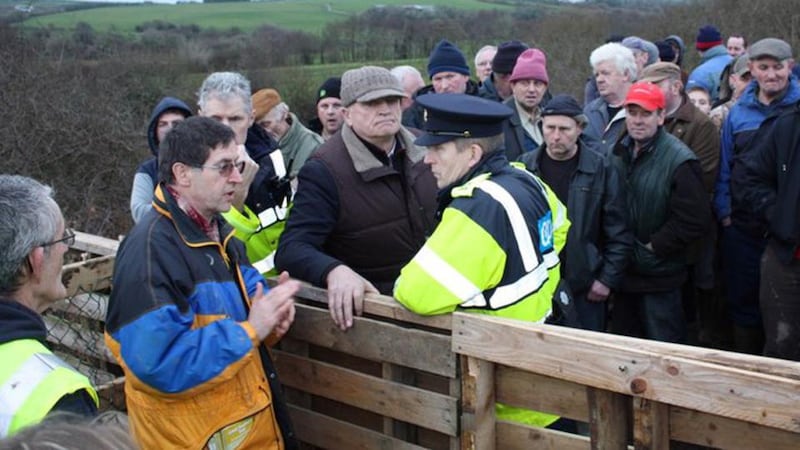The idea of turning abandoned railway lines into walking and cycling routes, called greenways, is catching on. Indeed, Taoiseach Enda Kenny knows all about the success of the longest greenway in Ireland, running from Westport to Achill, in his Mayo constituency.
“Escape the bustle of urban life on the 42km Great Western Greenway,” says the brochure; it followsthe route of the Westport-Achill railway, which closed as long ago as 1937. The pleasure is not just in an off-road trek but in spectacular Atlantic scenery too.
The spin-offs have been impressive, with bike-rental shops in towns along the route, long-established hotels rebranding as “Greenway Hotels” and farmhouses turning into B&Bs. It has also been recognised by the Eden award as a “European destination of excellence”.

The success of the Great Western Greenway has overtaken that of others, such as the Great Southern Trail group, which has been working hard to install a walking and cycling route on sections of the former Limerick-Tralee railway line.
On February 2nd, to mark the 50th anniversary of its closure, about 150 members and supporters of the Great Southern Trail set out from the old railway station at Abbeyfeale, Co Limerick, along the most recently developed section to cross the Kerry county boundary.
The trailers were greeted by a barricade on the border, manned by more than 30 farmers, including the Listowel Fine Gael town councillor Denis Stack. A stand-off continued for three hours, with the Garda mediating in vain.
The farmers were trying to lay claim to the land occupied by the disused railway line, even though Minister for Transport Leo Varadkar had made it clear that CIÉ "is the owner of the property [and] will object to any application by others to register these lands".
Cllr Stack made no comment when contacted by The Irish Times . A spokesman for the newly formed North Kerry Abandoned Rail Line Action Group, which organised the protest, said it was "in the process of making a claim on the land through adverse possession"; that is, farmers along the route had occupied the land without CIÉ's consent for a long time, thereby establishing their perceived rights to it.
Planning process
As a result of its perceptions of legal uncertainty, as well as concerns expressed by the farmers about issues of security and privacy if the route were developed as a greenway, Kerry County Council has declined to initiate a Part 8 planning process to facilitate the scheme.
Liam O’Mahony, the chairman of the Great Southern Trail group, has seen such suspicion among farmers before. He recalls that there was widespread scepticism about the trail when it was mooted 20 years ago, but he says most farmers with land along the old railway in Co Limerick now see its benefits.
There have been problems, such as a slatted shed, built in 2007 by a cattle farmer, John Dowling, that encroaches on the line at Coolybrown, between Rathkeale and Ardagh. Dowling also erected a double set of gates, thus incorporating some 500m of the trail in his farmyard. Dowling says he has received planning permission to reorientate the shed so that it will no longer encroach on the trail. He also says the gates will be closed most of the time to “prevent people walking around my yard”.
O’Mahony says CIÉ has been less than vigilant in asserting its ownership of the land and that Limerick County Council has been slow to respond to alleged breaches of the Planning Acts, despite having invested €1.5 million of public funds in the development of the trail.
Given the Department of Transport policy on developing cycle routes, Varadkar said last April that he was concerned about “unauthorised and illegal encroachment on closed or abandoned railway lines” and Iarnród Éireann was being asked to take measures to prevent it.
Elsewhere, Brendan Quinn, of Enniscrone in Co Sligo, is campaigning for a greenway on the long-abandoned rail route between Athenry and Sligo, the so-called Western rail corridor. Although the Minister has said he wouldn't reopen it even as far as Tuam, he appears unwilling to dash the hopes of West on Track, which wants to see the entire line restored. "We have to be sensitive to the fact that people in the west of Ireland want to see regional balance," Varadkar told The Irish Times last December.
Quinn wants to see a 75km walking and cycling route installed on the corridor, from Collooney, near Sligo town, to Claremorris in Co Mayo, and even envisages that it could be connected to the Great Western Greenway via Kiltimagh and Castlebar to create a continuous 150km greenway. "Such a project would transform walking and cycling tourism in the west, with many small towns that never see a tourist benefiting," says Quinn. It would also "protect the alignment from further encroachment".
There is growing support for the greenway scheme. A new vision for Swinford in Co Mayo suggests that the old railway line "will be turned into a cycling path similar to the greenway in Mulrany". A survey of 1,300 people in the area has found it has overwhelming support.
On May 11th, West on Track is to hold a conference in Tuam to discuss how to push forward a commuter rail service on the Tuam to Athenry section of the Western Rail Corridor, as well as reopening the Tuam-Claremorris section for freight. But both are vain hopes.
Quinn is still looking for a meeting with Minister of State for Sport Michael Ring, who is from Mayo, to talk about the greenway project. Perhaps he should go directly to that even more powerful Mayo man, Enda Kenny, who is on record as saying: "I favour this kind of development."
See greenway.ie, southerntrail.net and sligomayogreenway.com








